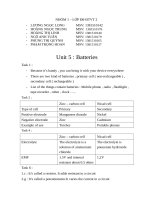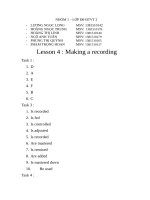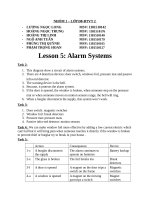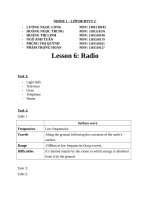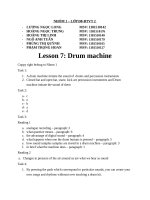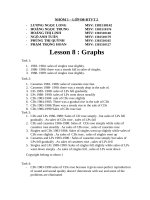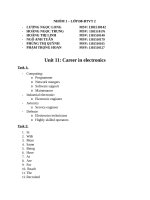ĐIỆN tử VIỄN THÔNG DTVT2 nhom10 bai6 txt khotailieu
Bạn đang xem bản rút gọn của tài liệu. Xem và tải ngay bản đầy đủ của tài liệu tại đây (55.32 KB, 6 trang )
Radio
D8-DTVT2
Group 10 :
Hà Tuấn Linh
Nguyễn Văn Hướng
Nguyễn Đức Thương
Nông Văn Quân
Trần Văn Quân
Vũ Văn Tu
Hà Đình Thanh Tâm
Task 1: Turning in
Study this diagram. Name five things, other than radio which make
use of electromagnetic waves.
Rays
Gamma rays
Ultraviolet rays
Infra-red rays
Radio waves
Wavelength
Task 2: Reading Information transfer
Proagation of radio waves
Radio waves from a transmitting aerial can travel in one or more of three different
ways.
Surface or ground wave
This travels along the ground, following the curvature of the earth’s surface. Its
range is limited mainly by the extent to which energy is absorbed from it by the
ground. Poor conductors, such as sand, absorb more strongly than water, and the
higher the frequency the greater the absorption. The range is about 1500km at low
frequencies (long waves).
Table 1
Frequencies
Travels
Range
Difficulties
Surface wave
Low Frequency
Along the ground
1500 km
Absorption by the ground
Task 3: Work in pairs
Sky wave
It travels skywards and, if it is below a certain critical frequency (typically
300MHz), is returned to earth by the ionosphere. This consists of layers of air
molecules stretching from about 80km above the earth to 500km. On striking the
earth, the sky wave bounces back to the ionosphere where it is again gradually
refracted and returned earthwards as it by ‘reflection’. This continues until it is
completely attenuated.
The critical frequency varies with the time of day and the seasons. Sky waves of
high frequencies can travel thousands of kilometres but at VHF and above the
usually pass through the ionosphere into outer space.
Space wave
For VHF, UHF, and microwave signals, only the space wave, giving line of sight
transmission, is effective. A range of up to 150km is possible on earth if the
transmitting aerial is on high ground and there are on intervening obstacles such
as hills, buildings, or trees. Space waves are aslo used for satellite
communications
Frequencies
Travels
Range
Difficulties
Sky wave
Space wave
below 300MHz
Skywards and returned to
earth by the ionosphere
VHF, UHF
Thousans km
attenuated by refraction
line of sight transmission
150km
hills, buildings, or trees
Task 4: With the help of Table 1 and 2, label the diagram using these
labels:
1-a transmitting aerial
2-e surface wave
3-d space wave
4-c sky wave
5-b receiving aerial
Task 5: Link these pairs of actions. Use short ways when this is
possible.
1, When the switch is closed, current flows through the primary of the
Transformer
2, On striking, The radar signal is reflected
3, When discharging quickly, A cell may become hot
4, On receiving signals from the remote control, the TV follows your instructions.
5, On receiving the reflected signal, the signal is compared with the transmitted
signal.
6,When choosing a course in electronics, you think carefully about your future.
7, On striking a high building, microwave signals are deflected.
8, When making a recording, you should ensure the recording levels are
satisfactory.
9, On detecting an intruder, the alarm triggers an audible warning.
10,On pressing remote control button, the television set changes channel.
Task 6: Speaking practice
Task 7: Word study Word formation
Verb
Noun (component)
Noun (property)
Absorb
Attenuate
Absorption
Attenuation
Absorber
Attenuator
Communicate
Conduct
Induct
Modulate
Reflect
Resist
Communicator
Conductor
Inductor
Modulator
Reflector
Resistor
Communucation
Conductivity
Induction
Modulation
Reflection
Resistance
Task 9: Technical Reading
1 : AF
audio frequency
2 : RF
Radio frequency
3 : AM
Amplitude modulated
4: FM
Frequency modulated
Task 10: Identify the waves. Use these terms:
a : RF carier
b: AF signal
c: AM carrier
d: FM carrier
Task 11: Explain what happens at each stage in this flowchart,
which shows how a radio works. The first and last stage are done for
you.
Component
Function
Aerial
Receiver weak RF signals
RF tuner
Modulater Rf carrier
RF amplifier
Amplifier RF wave
Detector
Detect RF signal
AF amplifier
Amplifier AF signal
Loudspeaker
Convert the audio signal into sound
Task 12:.
Radio waves are very popular in today's life. It was used extensively in the field of
communication today. Here are all described block diagram of a simple radio
receiver.
Diagram includes seven components. Aerial is receiving antenna, receiver RF
carrier is modulated and put into an amplifier. Audio signal is separated from the
carrier and into the audio signal amplifier and power amplifier signal. audio signal
after amplification was converted and emitted speakers.

